I want to run a tree regression. The data is this format:
L2 L3 L4 L5 L6 ele ndvi nd_var nd_ps ldclas
1 0.010814554 0.11304182 0.1360298 0.2098749 0.2437155 179 0.012483470 286688.2 7361 agri
2 0.010853562 0.10954640 0.1279681 0.1986370 0.2224236 183 -0.005020924 383210.9 7353 agri
3 0.011879258 0.12245614 0.1507865 0.2681184 0.2980641 184 0.005531083 1210329.6 7539 agri
4 0.009947186 0.09288491 0.1018834 0.2433811 0.2778357 193 -0.043884473 372672.2 7189 agri
5 0.010979766 0.10698310 0.1283619 0.2131286 0.2349639 193 -0.022636201 472360.7 7392 agri
6 0.011418039 0.11616439 0.1401070 0.2539036 0.3128864 195 -0.001042468 629364.2 7263 agri
ldclas is the dependent variable. ldclas has 10 levels, namely agri, tea, teak, rubber etc..
output of dput(tt) is
structure(list(L2 = c(0.00912571167754499, 0.00930928144178689,
0.00934829001668829, 0.0088274108106519, 0.00936205774900643,
0.00895361502356821, 0.00898573973231054, 0.00755389557122373,
0.0075997880122842, 0.00758602027996606, 0.00788891039096519,
0.00775582231188981, 0.00781777710732146, 0.00793250820997264,
0.00815738117116897, 0.00817114890348711), L3 = c(0.0878981140668165,
0.0923722488117655, 0.0880612335627261, 0.0763632354274946, 0.0775283746839917,
0.082748198553099, 0.0864766441738899, 0.0545518285458678, 0.0588628437949073,
0.0566956847778226, 0.0579540351748395, 0.0588628437949073, 0.0606105526796531,
0.0575345850425006, 0.0649681734989524, 0.0623116559941389),
L4 = c(0.0848333226476736, 0.0903004613645694, 0.088516691528972,
0.073088240743156, 0.0761924635739359, 0.0779299017254917,
0.0815206072387071, 0.036532542034421, 0.0375518390833337,
0.0378298291875827, 0.0388722920785162, 0.0384089752381013,
0.0395672673391385, 0.0402622425997609, 0.0436212896927688,
0.0423240025396071), L5 = c(0.22561265031896, 0.236273695432274,
0.208398062322137, 0.17396888632849, 0.135616814946827, 0.208075000349006,
0.217836087108599, 0.118148392542544, 0.198013927471506,
0.166792295353943, 0.149716162488461, 0.183937655785095,
0.18880666123728, 0.129386334036449, 0.223697354335399, 0.193560287413347
), L6 = c(0.177203322015849, 0.200068266889341, 0.190253179119034,
0.163732501780303, 0.16849603196228, 0.173259562144258, 0.184647722672334,
0.0603306628998872, 0.0772578120116587, 0.0753302439845328,
0.0664678622506211, 0.0696583196748293, 0.0774350596463369,
0.0615492403883001, 0.0991922068030903, 0.0796728110341496
), ele = c(666, 773, 766, 678, 787, 809, 857, 738, 748, 855,
500, 612, 588, 397, 261, 258), ndvi = c(-0.0283995447391665,
-0.0135402419404802, -0.0395083528567925, -0.0819444409706586,
-0.103586067539291, -0.0490366118119649, -0.0288226681221347,
-0.17071641510358, -0.136545326259316, -0.154017449391041,
-0.16240155229558, -0.146503439773889, -0.136064892814646,
-0.168614157809797, -0.122837753698589, -0.144167470536185
), nd_var = c(131202.666666667, 433640.666666667, 461440.222222222,
210334.888888889, 79202, 4817.55555555556, 55640.6666666667,
105110.222222222, 263000.888888889, 63993.5555555556, 95738.8888888889,
29214, 34386.8888888889, 74852.6666666667, 63421.5555555556,
47259.5555555556), nd_ps = c(7836, 7407, 8644, 7460, 8731,
7675, 8202, 8457, 8160, 8152, 7705, 8108, 8016, 7898, 7901,
7946), ldclas = structure(c(4L, 4L, 4L, 4L, 4L, 4L, 4L, 5L,
5L, 5L, 5L, 5L, 5L, 5L, 5L, 5L), .Label = c("agri", "coconut",
"DDF", "grass", "MDF", "rubber", "tea", "teak", "water",
"young rubber"), class = "factor")), .Names = c("L2", "L3",
"L4", "L5", "L6", "ele", "ndvi", "nd_var", "nd_ps", "ldclas"), row.names = 95:110, class = "data.frame")
I have used the following code:
library(party)
ct <- ctree(ldclas ~ L2 + L3 + L4 + L5 + L6 + ele + ndvi + nd_var + nd_ps, data = tt)
I get the result like:
1) ele <= 637; criterion = 1, statistic = 216.044
2) L3 <= 0.09185959; criterion = 1, statistic = 187.431
3) L5 <= 0.05141302; criterion = 1, statistic = 165.797
4)* weights = 12
But I am not able to know which class of dependent variable is segregated in the regression tree. Eg: which class of response variable is getting classified for ele >637 and what is the code to get this on the plot?
